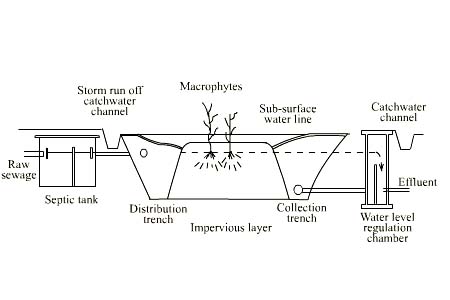Home
Lecture
Quiz
Design Example |
Aquatic Plant Systems
Aquatic systems in waste treatment are either free floating growths harnessed in the form of built-up ponds for waste treatment such as duckweed and hyacinth ponds or rooted vegetations (reeds) which emerge out of shallow waters cultivated in constructed wetlands.
- Natural wetlands exists all over the world. They generally have saturated soil conditions and abound in rooted vegetation which emerges out of shallow waters in the euphotic zone. They may also have phytoplankton. Natural wetlands can be integrated with wastewater treatment systems.
- Constructed wetlands are man-made for treatment of wastewater, mine drainage, storm drainage, etc. They have rooted vegetation.
Longitudinal Section Through a Typical Reed Bed With Gravel, Sand or Selected Soil With Horizontal Flow of Wastewater

- Aquatic plant ponds consisting of free floating macrophytes, such as water hyacinths, duckweeds, etc. have been cultured in ponds either for their ability to remove heavy metals, phenols, nutrients, etc. from wastewaters or to assist in giving further treatment to pretreated wastewaters to meet stringent discharge standards while at the same time producing new plant growths for their gas production or food value.
Conceptual flowsheet showing waste treatment using an aquatic plant pond

|